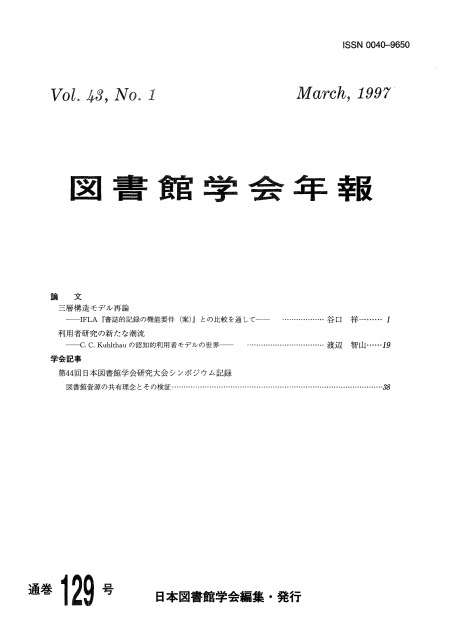All issues

Volume 43 (1997)
- Issue 4 Pages 145-
- Issue 3 Pages 103-
- Issue 2 Pages 49-
- Issue 1 Pages 1-
Volume 43, Issue 3
Displaying 1-3 of 3 articles from this issue
- |<
- <
- 1
- >
- >|
Article
-
Zensei OSHIRO, Kosuke KAJIArticle type: Article
1997 Volume 43 Issue 3 Pages 103-116
Published: September 30, 1997
Released on J-STAGE: August 03, 2017
JOURNAL FREE ACCESSA survey was made on Japanese Web and telnet OPACs, which numbered 136 in April 1997, from the standpoint of the functions and user interfaces which OPAC should have. The functions and user interfaces covered in this paper are: types of searchable files; access points; kinds of displays; login command; search methods (simple searching, menu-driven or command method, et.); boolean operation; help functions such as explanation, examples and feedback messages; search history; browsing of indexed terms, etc. The result shows that the number of the Web OPACs has rapidly increased during last few years, now surpassing that of telnet OPACs. Another finding indicates that the functions and user interfaces which the Japanese Internet OPACs provide are not satisfactory and that they have special problems with subject access and help functions.View full abstractDownload PDF (1741K) -
Nobuyuki MIDORIKAWAArticle type: Article
1997 Volume 43 Issue 3 Pages 117-128
Published: September 30, 1997
Released on J-STAGE: August 03, 2017
JOURNAL FREE ACCESSTwo concepts of facets have been used in studies of classification systems; one is for systems which take hierarchical structure and the other is for systems which take multi-dimensional structure. Both of them correspond to "principles of division". However, the concept of facets in multi-dimensional structure systems is used for grasping a subject from many aspects. Therefore, this concept should be equivalent to the broadest or most fundamental principle of division in order to grasp a multiplicity of aspects, and this fits the common meaning of facet, as "any of the many sides of a cut stone or jewel" or "aspect of a situation or problem". On the other hand, the concept of facets used in hierarchical systems does not have the role of grasping a subject from many aspects, but just the significance of a coherent set of items. This concept is not distinguished from the principle of division. Therefore, there is no purpose to introducing a concept of facets into hiererchical systems in addition to the principle of division.View full abstractDownload PDF (1248K) -
Shoichi TANIGUCHIArticle type: Article
1997 Volume 43 Issue 3 Pages 129-139
Published: September 30, 1997
Released on J-STAGE: August 03, 2017
JOURNAL FREE ACCESSThis paper proposes an approach to the analysis of cataloging rules as bibliographic description rules in terms of the 'oriented-ness', which refers to the directiveness to a given objective or function. Firstly, some categories of the oriented-ness are extracted from the general objectives and functions of bibliographic description indicated in cataloging rules and other documents, and also other categories of the oriented-ness are extracted from other parts of the cataloging rules. Secondly, relationships among those categories of the oriented-ness are examined. Thirdly, the principles of description and the bibliographic elements consisting of description established in current cataloging rules are assessed in terms of the above oriented-ness. Lastly, it is investigated to what extent each individual rule which mainly prescribes the methods to transcribe a bibliographic element can be explained in terms of the oriented-ness by examining, for example, each of the rules contained in Nippon Cataloging Rules, 1987 Edition, 1994 Revision. This paper assesses the validity and usefulness of the proposed approach and also considers its problems and issues.View full abstractDownload PDF (1433K)
- |<
- <
- 1
- >
- >|